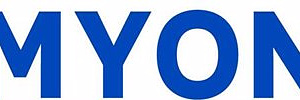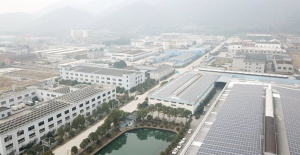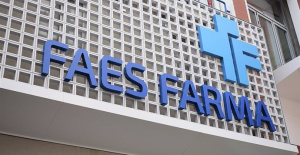The device combines medical imaging techniques and AI
VALENCIA, May 10. (EUROPA PRESS) -
The Nuclear Safety Council (CSN) has granted funding to develop a new project at the Institute of Corpuscular Physics (IFIC), a joint center of the Higher Council for Scientific Research (CSIC) and the University of Valencia (UV), to evaluate a technology that improves nuclear waste management.
This is the Proton project, which aims to develop evaluation methodologies to test a tomographic technology developed at the IFIC that allows "visualizing, analyzing and controlling nuclear waste activity." The project team will take measurements and test these evaluation methodologies at the Garoña nuclear power plant (Burgos), as reported by the CSIC CV in a statement.
This project is born from a collaboration that began in 2015 between an IFIC research team led by CSIC scientist Francisco Albiol and the National Radioactive Waste Company (Enresa). They developed a series of disruptive technologies that allow dynamic tomography of gamma radiation from the radioactive isotopes of nuclear waste, thus facilitating its classification and reducing costs in the process of dismantling nuclear power plants, which are estimated at around 4,000 million euros in Spain.
Until now, static procedures have been used to determine the activity and dose of a radioactive waste container. "The technology that we have developed at the IFIC allows a more agile and independent tomographic reconstruction of the shape of the container and the position of the detectors, taking advantage of the recognition of the environment through intelligence and artificial vision, as well as tomographic techniques adapted from medical imaging. ", explained Francisco Albiol.
However, this technology requires an evaluation by the regulatory body, the CSN, before its incorporation into the industry. In this context, the main objective of the Proton project is to "familiarize" the CSN with the use, advantages and limitations of the technology developed by the IFIC, as well as to compile relevant aspects for their calibration and management.
"During the implementation of the project, we seek to evaluate portable and geometry-independent gamma ray tomography devices, in order to guarantee their ability to estimate the distribution and quantification of activity and dose accurately," summarized the project coordinator at the CSN, Juan González Cadelo.
For the correct evaluation of the developed technologies, the members of the project have among their objectives to go to the Garoña nuclear power plant (Burgos), where measurements will be taken and the implemented methodologies will be tested. Currently, a prototype for the tomographic reconstruction of gamma activity and its three-dimensional distribution in nuclear waste containers has already been validated, which has led to several patents for these developments.
This project not only seeks to provide criteria that "inspire confidence" in the technology to characterize nuclear waste, but also "meet industry regulatory requirements and establish limits that ensure the proper functioning of this innovative technology." "With Proton we hope to significantly improve the evaluation and management processes of nuclear waste, thus contributing to safety and efficiency in the nuclear industry," concluded Albiol.

 Exploring Cardano: Inner Workings and Advantages of this Cryptocurrency
Exploring Cardano: Inner Workings and Advantages of this Cryptocurrency Seville.- Economy.- Innova.- STSA inaugurates its new painting and sealing hangar in San Pablo, for 18 million
Seville.- Economy.- Innova.- STSA inaugurates its new painting and sealing hangar in San Pablo, for 18 million Innova.- More than 300 volunteers join the Andalucía Compromiso Digital network in one month to facilitate access to ICT
Innova.- More than 300 volunteers join the Andalucía Compromiso Digital network in one month to facilitate access to ICT Innova.-AMP.- Ayesa acquires 51% of Sadiel, which will create new technological engineering products and expand markets
Innova.-AMP.- Ayesa acquires 51% of Sadiel, which will create new technological engineering products and expand markets Sunak apologizes 'with all my heart' for cover-up of contaminated blood transfusions
Sunak apologizes 'with all my heart' for cover-up of contaminated blood transfusions The UCO says that Koldo tried to meet with the president of ADIF because a businessman asked him to use "his influence"
The UCO says that Koldo tried to meet with the president of ADIF because a businessman asked him to use "his influence" Visalia and Atlantica sign a 'PPA' for a new solar plant in Spain
Visalia and Atlantica sign a 'PPA' for a new solar plant in Spain The Ibex 35 closes the first session of the week with an advance of 0.10%, to 11,340 points
The Ibex 35 closes the first session of the week with an advance of 0.10%, to 11,340 points How Blockchain in being used to shape the future
How Blockchain in being used to shape the future Not just BTC and ETH: Here Are Some More Interesting Coins Worth Focusing on
Not just BTC and ETH: Here Are Some More Interesting Coins Worth Focusing on 'Fallero hologram: the art of the bow', the UPV and Telefónica pioneer the use of VR technology applied to training
'Fallero hologram: the art of the bow', the UPV and Telefónica pioneer the use of VR technology applied to training UA researchers develop a device to desalt food products through electrodialysis
UA researchers develop a device to desalt food products through electrodialysis The UA participates in the proposed Ramses mission to study the close passage of an asteroid to Earth
The UA participates in the proposed Ramses mission to study the close passage of an asteroid to Earth They develop a tool to end discrimination biases in AI
They develop a tool to end discrimination biases in AI A million people demonstrate in France against Macron's pension reform
A million people demonstrate in France against Macron's pension reform Russia launches several missiles against "critical infrastructure" in the city of Zaporizhia
Russia launches several missiles against "critical infrastructure" in the city of Zaporizhia A "procession" remembers the dead of the Calabria shipwreck as bodies continue to wash up on the shore
A "procession" remembers the dead of the Calabria shipwreck as bodies continue to wash up on the shore Prison sentences handed down for three prominent Hong Kong pro-democracy activists
Prison sentences handed down for three prominent Hong Kong pro-democracy activists ETH continues to leave trading platforms, Ethereum balance on exchanges lowest in 3 years
ETH continues to leave trading platforms, Ethereum balance on exchanges lowest in 3 years Investors invest $450 million in Consensys, Ethereum incubator now valued at $7 billion
Investors invest $450 million in Consensys, Ethereum incubator now valued at $7 billion Alchemy Integrates Ethereum L2 Product Starknet to Enhance Web3 Scalability at a Price 100x Lower Than L1 Fees
Alchemy Integrates Ethereum L2 Product Starknet to Enhance Web3 Scalability at a Price 100x Lower Than L1 Fees Mining Report: Bitcoin's Electricity Consumption Declines by 25% in Q1 2022
Mining Report: Bitcoin's Electricity Consumption Declines by 25% in Q1 2022 Oil-to-Bitcoin Mining Firm Crusoe Energy Systems Raised $505 Million
Oil-to-Bitcoin Mining Firm Crusoe Energy Systems Raised $505 Million Microbt reveals the latest Bitcoin mining rigs -- Machines produce up to 126 TH/s with custom 5nm chip design
Microbt reveals the latest Bitcoin mining rigs -- Machines produce up to 126 TH/s with custom 5nm chip design Bitcoin's Mining Difficulty Hits a Lifetime High, With More Than 90% of BTC Supply Issued
Bitcoin's Mining Difficulty Hits a Lifetime High, With More Than 90% of BTC Supply Issued The Biggest Movers are Near, EOS, and RUNE during Friday's Selloff
The Biggest Movers are Near, EOS, and RUNE during Friday's Selloff Global Markets Spooked by a Hawkish Fed and Covid, Stocks and Crypto Gain After Musk Buys Twitter
Global Markets Spooked by a Hawkish Fed and Covid, Stocks and Crypto Gain After Musk Buys Twitter Bitso to offset carbon emissions from the Trading Platform's ERC20, ETH, and BTC Transactions
Bitso to offset carbon emissions from the Trading Platform's ERC20, ETH, and BTC Transactions Draftkings Announces 2022 College Hoops NFT Selection for March Madness
Draftkings Announces 2022 College Hoops NFT Selection for March Madness























